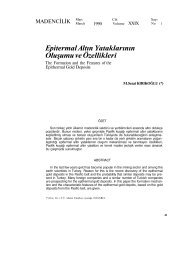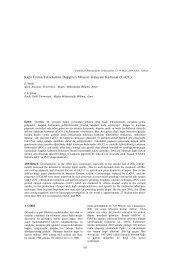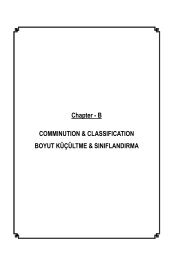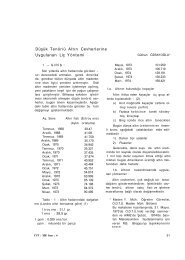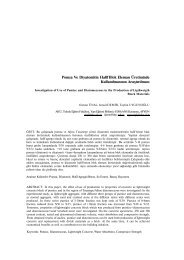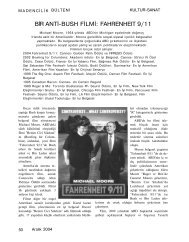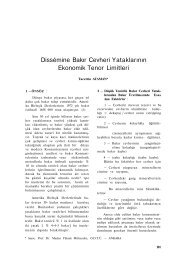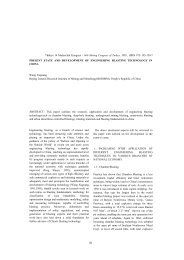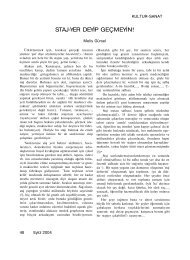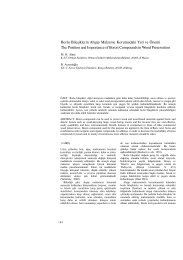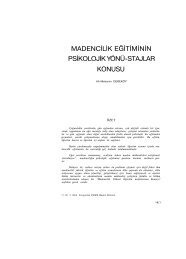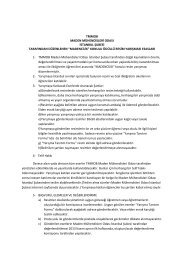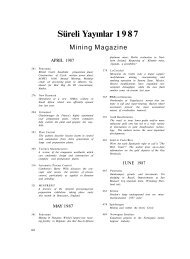A OPEN PIT MINING AÇIK OCAK MADENCİLİĞİ
A OPEN PIT MINING AÇIK OCAK MADENCİLİĞİ
A OPEN PIT MINING AÇIK OCAK MADENCİLİĞİ
Create successful ePaper yourself
Turn your PDF publications into a flip-book with our unique Google optimized e-Paper software.
23 rd <br />
two main pudding layers met the wadi with a<br />
down-slop dip, because this setting fostered<br />
a “controlled” slip-down of the extracted<br />
stone-blocks.<br />
In one of the quarry, probably worked out<br />
by the Romans, an undercut technique was<br />
used which led to a general rock-fall of a<br />
huge mass of the pudding layer down into<br />
the wadi bottom.<br />
The fallen blocks were up to many cubic<br />
meters in volume and therefore were later<br />
cut into smaller blocks dressed to the right<br />
size. In order to reduce blocks to the right<br />
size a line of wedge-shaped holes was<br />
chiselled, and then subsequently iron wedges<br />
were inserted into the holes and hammered<br />
until the block split along the line of holes<br />
(Fig.6).<br />
Figure 6. The main quarry of “Breccia Verde<br />
Antica”: the outcrop was dismantled<br />
according to its natural discontinuity<br />
network, the fallen blocks were subsequently<br />
dressed to the right size.<br />
Wedging was used for rough splitting,<br />
but, for a more controlled cut, quarriers used<br />
the “pointillé” pits method: a straight line of<br />
small, shallow pits was chiselled across the<br />
block surface, then quarriers inserted special<br />
short chisels along the pits and hammered<br />
them back and forth until the block split<br />
away (Harrell & Storemyr, 2009).<br />
4.2.3 - Use<br />
In the Pharaonic period the Breccia Verde<br />
Antica was seldom used: the fragment of the<br />
head from the lid of the inner sarcophagus<br />
belonging to Ramses II is considered to be<br />
made of “green conglomerate”, and the<br />
sarcophagus of Nectanebo II as well (both in<br />
the British Museum) (Aston et al., 2000; De<br />
Putter & Karlshausen, 1992). “Breccia Verde<br />
Antica” was used by the Romans to make<br />
many beautiful bowls and other objects, the<br />
most outstanding ones being the column,<br />
made by the order of Emperor Justinian (VI<br />
Century A.D.) for the church of San Vitale<br />
in Ravenna (Italy), where it still is, and three<br />
other columns in Rome (Borghini, 1989;<br />
Harrel et al., 2002).<br />
4.3 Granite of the Wadi Umm Fawakhir<br />
Close to Bir Umm Fawakhir there are some<br />
small granite quarries.<br />
4.3.1 - Geology<br />
The granite is actually a mainly a pinkishgrey,<br />
coarse- to mainly medium-grained<br />
granodiorite referable to the older granitic<br />
complexes. The granite is massive, affected<br />
by two sets of sub-vertical fractures N-S and<br />
E-W trending, respectively. These fractures<br />
can be grouped into bands with fractures up<br />
to a meter wide or can be scattered and<br />
spaced some meters wide; flat lying joints<br />
(Closs, 1922) are also present. The granite<br />
surface is fresh to slightly weathered mostly<br />
along the fractures (Thuro & Sholz, 2003);<br />
all the fine particles had been removed by<br />
wind and rainfall; large amounts of residual<br />
core stones are present.<br />
4.3.2 - Quarrying<br />
The quarriers used boulders and cobbles or,<br />
due to it massive setting (Fig.7).<br />
Figure 7. The main of the small granite<br />
quarries at Bir Umm Fawakhir.<br />
15



